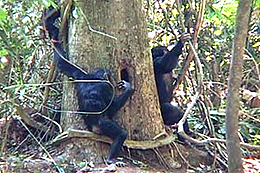Research Abstract
情動的な画像に対するチンパンジーの脳の反応
Brain response to affective pictures in the chimpanzee
2013年2月26日 Scientific Reports 3 : 1342 doi: 10.1038/srep01342

非侵襲的な脳機能測定法の進歩によって、ヒトの情動の処理過程に関与する神経活動を詳しく調べることが可能になった。しかし、ヒトに最も近縁な現生動物であるチンパンジーを対象として、ヒトと比較対照できるデータは得られていない。本研究で我々は、無麻酔の状態で成体チンパンジーが情動的な画像と中立的な画像を見た時の、事象関連脳電位を測定した。その結果、情動的な画像を提示した210ミリ秒後に、中立的な画像の場合とは異なる脳電位が現れ、そのパターンがヒトの場合と似ていることが明らかになった。このことから、情動の処理過程の少なくとも一部は、ヒトとチンパンジーで類似していると考えられる。この結果は、情動の伝染や共感といった情動現象の進化的基盤を考えるうえでも意義あるものである。
平田 聡1, 5, 松田 剛2, 上野 有理3, 福島 宏器4, 不破 紅樹1, 洲鎌 圭子1, 楠木 希代1, 友永 雅己5, 開 一夫2 & 長谷川 寿一2
- 林原 類人猿研究センター
- 東京大学 大学院総合文化研究科
- 滋賀県立大学 人間文化学部
- 関西大学 社会学部
- 京都大学 霊長類研究所
Advancement of non-invasive brain imaging techniques has allowed us to examine details of neural activities involved in affective processing in humans; however, no comparative data are available for chimpanzees, the closest living relatives of humans. In the present study, we measured event-related brain potentials in a fully awake adult chimpanzee as she looked at affective and neutral pictures. The results revealed a differential brain potential appearing 210 ms after presentation of an affective picture, a pattern similar to that in humans. This suggests that at least a part of the affective process is similar between humans and chimpanzees. The results have implications for the evolutionary foundations of emotional phenomena, such as emotional contagion and empathy.

